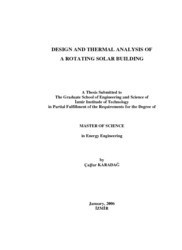Please use this identifier to cite or link to this item:
https://hdl.handle.net/11147/3255| Title: | Design and thermal analysis of a rotating solar building | Authors: | Karadağ, Çağlar | Advisors: | Günaydın, Hüsnü Murat | Publisher: | Izmir Institute of Technology | Abstract: | In recent years, various rotating buildings such as residential buildings, restaurants and pubs have been designed and constructed. Most of these rotating buildings do not possess passive solar design features or they cannot respond passive solar design principles entirely because the primary design purpose of these rotating buildings is to make all spaces view the landscape as required.Passive solar design is the optimum utilization of architectural peculiarities of a building and appropriate material selection for improving energy efficiency of a building in heating, cooling and natural lighting. While projecting a passive solar building, different factors including building orientation, latitude of the location and climatic properties must be taken into consideration.Although passive solar buildings are superior to conventional buildings in terms of various aspects, they have some deficiencies as well. Despite insulation, largesouthfacing windows which are designed to maximize solar heat gain in winter turn out to be heat loss areas in cold winter nights. They also cause excessive solar heat gain in summer. So as to eliminate such disadvantages of passive solar buildings, direction of buildings can be changed in winter and in summer by rotating them. In this project, a rotating building.s thermal performance is investigated. For doing this, a thorough literature review is carried out. First, passive solar design tools are identified. Second, examples of rotating buildings are analysed. Then, a rotating cafe located at IZTECH Campus . IYTE Cafe - is designed on the basis of passive solar design criteria. The cafe is assumed to be rotating two times a year and performance of the building is compared with a conventional passive solar building by calculating heat gain and heat loss of each building. It is found that, substantial energy savings could be possible through a rotating building. Furthermore, energy savings in summer and in winter conditions are calculated respectively as 14 % and 23 %. | Description: | Thesis (Master)--Izmir Institute of Technology, Energy Engineering, Izmir, 2005 Includes bibliographical references (leaves: 113-116) Text in English; Abstract: Turkish and English xiv, 122 leaves |
URI: | http://hdl.handle.net/11147/3255 |
| Appears in Collections: | Master Degree / Yüksek Lisans Tezleri |
Files in This Item:
| File | Description | Size | Format | |
|---|---|---|---|---|
| T000358.pdf | MasterThesis | 2.61 MB | Adobe PDF |  View/Open |
CORE Recommender
Page view(s)
114
checked on Jul 22, 2024
Download(s)
84
checked on Jul 22, 2024
Google ScholarTM
Check
Items in GCRIS Repository are protected by copyright, with all rights reserved, unless otherwise indicated.